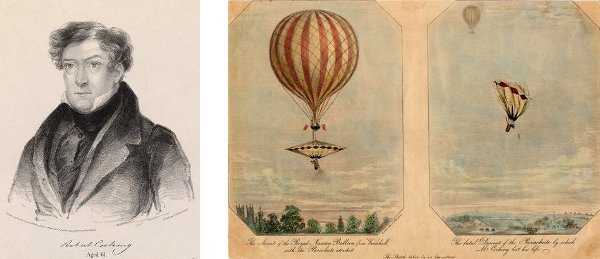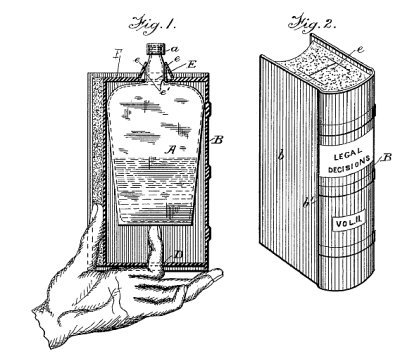
A Paris inventor patented this “cynophere,” or dog-powered velocipede, in 1875.
Twelve years later, a Cleveland designer offered this “motor for street-cars.” That’s progress.


A Paris inventor patented this “cynophere,” or dog-powered velocipede, in 1875.
Twelve years later, a Cleveland designer offered this “motor for street-cars.” That’s progress.


The following is an account of the post-mortem examination of the body of Mr. Robert Cocking, aged sixty-one, who fell with a suicidal machine called a parachute, from the cord of a balloon which ascended from Vauxhall Gardens, on the 24th of July, 1837. The height which the balloon had reached when the parachute commenced its descent, is stated to have been 5000 feet. The instrument of death was simply a canvas toy, constructed in ignorance, and used with the hardihood which might distinguish an unfortunate being who contemplated his own destruction by extraordinary and wonder-exciting means,– an end which, without the motive, was more effectually attained, by the crushing of the parachute in the air as it dropped:–
On the right side.–The second, third, fourth, and fifth ribs broken near their junction, with their cartilages. The second, fourth, fifth, and sixth broken also near their junction with the vertebrae. The second, fourth, fifth, and sixth ribs also broken at their greatest convexity.
On the left side.–The second, third, fourth, and sixth ribs broken near their cartilages, and also near their angles.
The clavicle on the right side fractured at the junction of the external with the middle third.
The second lumbar vertebra fractured through its body; the transverse processes of several of the lumbar vertebrae broken.
Comminuted fracture and separation of the bones of the pelvis at the sacro-iliac symphyses.
The ossa nasi fractured.
The right ankle dislocated inwards; the astragalus and os calcis fractured.
The viscera of the head, chest, and abdomen free from any morbid appearances.F.C. Finch, G. Macilwain, W. Maugham, T. Greenwood, W. Thompson, surgeons
— Lancet, Aug. 5, 1837

Inventor E.M. Waring patented a novel forerunner of the vacuum cleaner in 1914. Rather than an electric motor, his “suction cleaning apparatus” was powered by bellows strapped to the operator’s feet:
An apparatus of this kind presents the advantage that the operation thereof happens wholly instinctively, so to speak, and the operator is at liberty to give the entire attention to the handling of the cleaning nozzle and to the object to be cleaned.
He also envisioned a dust bag made of cheesecloth, “permitting passage of the air but retaining the dust.” Kudos.

In 1912, after decades of performing, Lillian Russell perfected a transportable trunk that opens into a fully equipped dresser with cosmetics, mirrors, and light fixtures:
The paramount objects of my invention are to provide a trunk with foldable devices that will permit of the trunk being used as a dresser; to afford means to quickly restoring the devices to a closed position, and to furnish means to rigidly securing the devices against accidental collapse when extended.
She intended it for use by touring actresses, but “I desire it to be understood that the same can be used by the traveling public and by campers.”

In the early 1970s, AI researcher James Meehan tried to teach a computer to retell Aesop’s fables. This was not always successful:
Once upon a time there was a dishonest fox and a vain crow. One day the crow was sitting in his tree, holding a piece of cheese in his mouth. He noticed that he was holding the piece of cheese. He became hungry, and swallowed the cheese. The fox walked over to the crow. The end.
Henry Ant was thirsty. He walked over to the river bank where his good friend Bill Bird was sitting. Henry slipped and fell in the river. He was unable to call for help. He drowned.
One day Henry Crow sat in his tree, holding a piece of cheese in his mouth, when up came Bill Fox. Bill saw the cheese and was hungry. He said, ‘Henry, I like your singing very much. Won’t you please sing for me?’ Henry, flattered by this compliment, began to sing. The cheese fell to the ground. Bill Fox saw the cheese on the ground and was very hungry. He became ill. Henry Crow saw the cheese on the ground, and he became hungry, but he knew that he owned the cheese. He felt pretty honest with himself, so he decided not to trick himself into giving up the cheese. He wasn’t trying to deceive himself, either, nor did he feel competitive with himself, but he remembered that he was also in a position of dominance over himself, so he refused to give himself the cheese. He couldn’t think of a good reason why he should give himself the cheese, so he offered to bring himself a worm if he’d give himself the cheese. That sounded okay, but he didn’t know where any worms were. So he said to himself, ‘Henry, do you know where any worms are?’ But of course, he didn’t, so he …
“The program eventually ran aground for other reasons,” Meehan writes. “I was surprised it got as far as it did.”
(From Meehan’s The Metanovel: Writing Stories by Computer, 1980.)

This is clever — in 1885 Andrew Morrison proposed an aerial railway consisting of a series of balloons linked by cables. As each balloon in turn is raised, the passenger car rides down the wire to the next station.
“To render the car as light as possible, a gas-compartment, S, is formed on the top thereof, which, when filled with gas, overcomes by its buoyancy a part of the gravity of the car.”

Naturalist George Merryweather offered a gruesome new instrument at London’s Great Exhibition in 1851: He imprisoned 12 leeches in a ring of bottles, which he capped with whalebone levers. (The bottles were arranged in a circle so that the leeches “might see one another and not endure the affliction of solitary confinement.”) When a storm approached, the agitated leeches would climb the bottles, trip the levers, and ring a bell. The more agitated this “jury of philosophical councilors,” the more frequently the bell sounded, and the more likely a storm.
After a year of experiments, Merryweather claimed great success — among other feats, the “leech barometer” foretold the disastrous storm of October 1850 51 hours before it took place. “I may here observe,” Merryweather wrote, “that I could cause a little leech, governed by its instinct, to ring Saint Paul’s great bell in London as a signal for an approaching storm.”
He proposed that the government install stations around the British coast, and nominated engineer William Reid to be inspector-general of leeches and meteorologist James Glaisher his second-in-command. Inexplicably, they turned him down. “After this,” opined Chambers’ Journal, “the Snail Telegraph looks not quite so outrageous an absurdity.”
John and Margaret Vivian declared bankruptcy in 1992, so they weren’t pleased when NationsBank sent them a dunning notice on a debt that had been discharged. The bank apologized, saying that a computer had generated the notice, but the Vivians received a second notice, then a third.
So Florida bankruptcy judge A. Jay Cristol held the computer in contempt of court:
ORDERED that the NationsBank computer, having been determined in civil contempt, is fined 50 megabytes of hard drive memory and 10 megabytes random access memory. The computer may purge itself of this contempt by ceasing the production and mailing of documents to Mr. and Mrs. Vivian.
The computer had no comment.

For the really determined alcoholic, in 1885 Herbert Jenner patented a liquor flask hidden in a book:
The ornamental covering [has] been made so as to entirely cover and conceal the flask from observation, and at the same time admit of ready access to its contents. … That portion of the covering representing the edges of the leaves of the book is covered with marbled paper or otherwise treated, so as to give a natural appearance.
Charmingly, the book is titled Legal Decisions.
As railroads were claiming the American West in the 1880s, they ran into a problem — stray cattle and horses kept wandering onto the tracks. What to do?
In 1883 La Fayette Willson Page of Tennessee suggested a spray attachment that would direct a stream of water from the engine’s boiler:

In 1885 Mississippi inventor William Bell proposed a Dr.-Seuss-like set of tongs that would extend a whistle and a spray nozzle closer to the livestock:

And in 1888 Jack William James, also of Tennessee, went full-on crazy and suggested a flatcar mounted with a dummy that would “throw up both hands at each revolution of the wheel and strike [a] gong with a hammer”:

I desperately wish this had caught on. How stubborn are Tennessee cows?